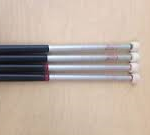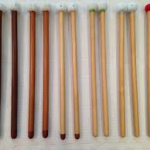My Instruments -Timpani Sticks|Part One
You might think it a little strange for me to talk about timpani sticks (or mallets –call them whatever you will) in a blog post with the heading “My Instruments.” However, when you think about it, timpani sticks are the tools one uses in the hands to make actual physical contact with the instrument, and the type of stick or mallet one uses will determine to a fairly large degree what type of sound one produces, so why not consider them under the heading “My instruments?” I am proceeding with this blog post under that premise.
My First Sticks (or Mallets)
When I was eleven years old, I was enrolled in the band program at Yorktown Junior High School in the village of Yorktown Heights, NY. My chosen instrument was timpani and percussion, and since I had a relatively good ear, it was decided (with full concurrence of yours truly) to start on timpani. As I reported in an earlier blog post, the school was in the process of equipping itself with a pair of timpani, and as an economy measure, chose not to buy new. The bought a pair of 1930s-vintage Ludwig Universals, which though they had seen a lot of wear, were in relatively good condition and had reasonably good heads. To a novice like me, they looked marvelous, and sounded great.
My parents decided that I should have my own timpani sticks, and with the aid of my cousin Frank Coderre, who then worked for Sam Ash Music in New York City, they purchased a pair of Ludwig medium-hard mallets, with maple-shafts. The medium-hard felt heads were screwed on to the shaft head and held in place with metal washers. I admit that I was very proud of them, and was particularly excited when my mother hand crafted a carrying case out of old, but neat and clean curtain material, with its own snap cover and carrying handle, and a red satin lining.
It took a while for the novelty to wear off, but I used those sticks throughout junior high and high school, and I added a general – purpose pair to the ones I originally had. They were of similar design – both being about 15 inches long with a shaft diameter of about ½ inch.
As I said, those pairs worked well throughout my junior high and high school years. In high school, I was using a set of 1960-vintage Ludwig Symphonic model timpani – the middle pair only. For some reason, the district wouldn’t shell out for outside drums (a 23 inch and 30 inch would have matched the 25 and 28 inch instruments that we were using) at the time. One’s school music organization could get by with two in the 50s and early 60s, but times were changing, although it did not change in the Yorktown School District # 2 until long after I had left.
My sticks looked really pathetic when I auditioned at the Hartt School of Music and Manhattan School of Music in the spring of 1970. Clearly, it was time to make a change.
My First Hinger Mallets
When I entered Manhattan School of Music in the fall of 1970, I was clueless and without proper equipment. Mr. Hinger and Jim Preiss, my two mentors at MSM quickly put me to rights as to gearing up for my studies, and I purchased my first set of Hinger mallets in the late fall of 1970. As I had to purchase a whole “kit” – triangle, tambourine, snare drum sticks, marimba, xylophone and bell mallets, as well as the required printed tutors and method books, I had to prioritize and get one pair at a time. Naturally, I started off with the green-coded general purpose. I purchased these directly from Dan (I kept in touch with him through Jim), and remember them costing me about $25.00 a pair, back when $25.00 was some kind of money. These were as different from my old Ludwig mallets as night and day.
I had first seen the Hinger mallets when I visited the sixth floor practice rooms at MSM during my first week there. A graduate student by the name of Ben Carriel was practicing in Room 612, and he had his case of timpani mallets open. They were the weirdest looking mallets I had ever seen. First off, the shafts were made of anodized aluminum, and they had rubber grips. Ben had redone his to surgical tubing, which were of a brownish color. There was a separate rubber ring atop the grip, which the player could move up and down to adjust the balance of the stick. The felt was either sewn on (later glued on) the head of the shaft, which was created by wrapping the tip of the shaft with masking tape, making that the core, and then the felt is sewn onto the core. The mallets came in several different types, each of which was color coded: Yellow – soft; Green – general purpose; Red: medium-hard; and Light Blue: Hard. The grips on the Hinger mallets were of black rubber. The diameter of the shafts were 5/8 inch, and length was about 15 and ½ inches.
I was used to the smaller Ludwigs, and the change to the Hinger mallets took some time to get used to. The sticks seemed like telephone poles in my hands, and I really had to work to get the feel of them and to get decent results . I eventually became quite comfortable with them, and by year’s end, I had a complete set of my own Hinger mallets. For years, these remained my mallets of choice, along with the wooden shafted mallets that Dan added to the line during my last two years. They had the same color coding, but had wooden shafts rather than the anodized aluminum.
My First Bamboo-Shafted Mallets
As my education progressed, I was introduced to the use of bamboo-shafted mallets, both by Dan Hinger himself, and by my school colleagues, It started in my sophomore year, when I was invited to sit in the pit at the Met for a performance of La Boheme. Before the performance started, as I watched Dan make his preparations for the performance, from getting the heads ready and sorting out his mallets of choice, I noticed that he had several pairs of bamboo shafted mallets at the ready. He picked up a pair of what he considered general –purpose mallets and handed them to me, asking me to try them out. These had the golden surgical tubing for grips, although he had several pairs with black rubber grips as well. The heads were ball-shaped, and the felt was sown on, with the stitch marks outlined in marker in order to make it easy for the player to see and avoid “playing on the seams.” They felt a little different than the aluminum mallets, but they were well-made and had a good balance, and in the hands of a master like Dan, they sounded unbelievably good.
I remember asking Dan if he preferred bamboo to either wood or aluminum, and he answered that he indeed loved the feel and sound produced by bamboo mallets, as he felt that the material was almost “alive”. He did not make bamboo mallets for sale – he reserved those for his own use. I asked him that if he preferred bamboo mallets, why manufacture the aluminum and wood shafted variety? His answer was most interesting, and here it is, to the best of my recollection:
“While bamboo is my preference due to the fact that it “breathes”, and has a great feel to it, in a large hall like the Academy of Music in Philadelphia – especially after the acoustics were changed by the addition of an organ – it didn’t project as well as it did before the organ was added. I experimented with several different materials, and with the help of my assistant timpanist, we decided that the aluminum projected much better.”
I thought on this long and hard over the rest of the time at Manhattan, and it wasn’t until my last year that I fully understood what he meant. From my junior year onward, I began to expand my collection of mallets beyond the standard set of Hinger aluminum mallets that I already owned.
Andrew Feldman “AF” mallets
One of my classmates was a tall, long-haired, quiet fellow by the name of Andrew Feldman. He was also a student of Dan Hinger, and was an excellent overall percussion player. I don’t recall him being an outstanding timpanist, but do remember him being a fine percussionist, particularly on mallets. He also had an outstanding talent as a mallet manufacturer – be it timpani mallets, bass drum and tam-tam mallets, and xylophone and bell mallets.
He started off making timpani mallets with bamboo shafts, and he did the work thoroughly, from selecting the bamboo: cutting it; varnishing it; selecting and cutting the felt; making the cores – he used the rolled tape process; sewing the felt to the cores, and then testing the finished product. He had a wide variety of types – from ultra-soft “Bruckner” mallets – to hard mallets – with thin red felt – coded red.
His mallets were well balanced. He generally followed the Hinger model with regard to shaft diameter and length. The shafts tended to be 5/8 inch in diameter, and about 16 inches long.
I wound up purchasing several pairs of sticks from him – a pair of yellow ultra-soft “Bruckner” mallets with yellow-gold surgical tubing rubber shafts; a pair of purple medium softs; green generals; blue medium hard; and red hards. I also bought a pair of bell mallets as well.
I still have the Bruckners in their original shape (although they have been recovered several times since), and I have the shafts for the purples, which have been recovered to a more general type mallet, and I have the greens in their original configuration, albeit re-covered several times since. The reds I experimented with, and head them shortened, and smaller heads placed on them.
In any case, those sticks also stood the test of time. I felt then, and still do – that Andy’s sticks were first class, and they enabled me to produce excellent tone from the timpani. He was my alternate go-to- source for re-covering as well as purchase, and my greatest regret is that he gave up the business several years after we graduated from college, and from what I understand, he has since become a rabbi.
He had his sticks stamped with a distinctive AF logo, with the F melded into the A. His sticks were so good, that even Dan Hinger was impressed. I suspect that Dan gave Andy a lot of inside tips on stick construction, and Andy had the kind of mind to retain that knowledge and patience to put it into actual practice. I just wish he was still around making those find mallets!
Other Mallets
I had bought other types of bamboo shafted mallets during my college years. Some were crafted by my friend Tom Wetzel (for many years Principal Percussionist and Associate Timpanist with the Milwaukee Symphony), and by Danny Haskins, now a respected New York free-lance percussionist. They made excellent quality mallets, and along with the Hinger and Feldman mallets, they were part of my “arsenal” for a good many years. They served me well during my years with the Albany Symphony, and later with the Evansville Philharmonic Orchestras.
Here is a video that I did last night, talking about the Hinger mallets.




Recent Comments